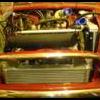
Camshaft Running In
#1

Posted 31 December 2013 - 12:15 AM
#2

Posted 31 December 2013 - 12:49 AM
Most engine builders will tell you to assemble the cam components with a quality assembly lube and upon engine startup, bring the engine to some elevated speed and hold it there for some period of time, 20 at 2000 as you stated is certainly one value I have heard.
By doing this procedure you are bedding in the components with one another. You do want to use new followers with your new cam as you said you will be doing. Running old parts with new can cause both to wear excessively. Also, if the cam itself is new and you are putting it in a fresh block, fit new cam bearings and provide the cam to the machine shop so they can size the cam bearings for you.
Edited by dklawson, 31 December 2013 - 12:50 AM.
reworded cam follower comment
#3

Posted 06 January 2014 - 11:40 PM
#4

Posted 07 January 2014 - 07:44 AM
"In pushrod engines oil throw-off from the crank may not be sufficient to lubricate the cam followers. Also contact stresses at the nose of the cam are very high at low speed."
#5

Posted 07 January 2014 - 08:02 AM
Not so sure about 20 minutes, as that's a long time. When I start an engine for the first time after rebuild then it be run for about 2 minutes between 2 and 3k rpm, or until the head is hand hot ( this is without water in the engine )
IMO, that will have bedded in most things like rings, cam followers and will have given the engine its first heat cycle and the oil a good chance to get round the system.
It's important that the cam and followers are well covered in assembly lube which will protect them for the first few seconds of running
#6

Posted 07 January 2014 - 10:55 AM
That's more or less what I do on an initial start-up.
I start it without any coolant and run it for about 30 seconds. Than I add coolant, re-start it and run it at around 1500 - 2000 rpm whilst I check for leaks and do any initial settings. After about 5 to 8 minutes I set the tickover to 1000 rpm, let it tickover until it's at normal operating temperature, setting the carb mixture at this time, then switch it off and let it fully cool.
I re-torque the head when it's fully cool and re-set the valve clearances, top up with coolant, re-check everything like fan belt, oil level, etc, and run it for another 10 minutes at 1000 rpm.
After that it's time to check the clutch setting and drive it a short distance.
After about 5 hours running I re-torque the head and re-set the valve clearances. If all is well it's time to either book a R-R session if it's a modified engine, or 'fine-tune' it by ear,
Well, others may do it differently, but that has worked for me over the years.
#7

Posted 07 January 2014 - 03:43 PM
I run at ~2500rpm for a minimum of 20 minutes then change the oil & filter.
From Piper Cams technical instructions:
"8. Do not idle engine during the first twenty minutes of operation; rpm should be kept at 2500 or above. In pushrod engines oil throw-off from the crank may not be sufficient to lubricate the cam followers. Also contact stresses at the nose of the cam are very high at low speed. If adjustments need to be made during the twenty minutes break-in period, shut the engine down. DO NOT IDLE."
http://www.pipercams...nstallation.php
From Kent Cams:
As a general rule it is important to ensure good oil flow during the camshafts first 20 minutes of life. Consequently it is essential to run the engine at a fast idle (above 2000 rpm) to ensure adequate lubrication of the camshaft and followers. This will allow the surfaces of the cam lobes and followers to bed in properly and guarantee long component life."
http://www.kentcams....rmation-faq.asp
Comp Cams:
"Proper Procedure
http://www.compcams....echBulletin.pdf
#8

Posted 07 January 2014 - 04:25 PM
#9

Posted 07 January 2014 - 05:18 PM
I very much doubt you would be able to do that unless you were on a racetrack or empty open road.
It is also a totally different kind of loading on the engine. Fast idling at ~2500 doesn't put any load on the engine as it isn't 'working', just turning quickly.
20mins seems like a long time, but it isn't really if you're perfoming cooling system checks and flashing a timing light about.
Also consider this:
What is 20 mins spent DOING WHAT ALL THE MANUFACTURERS TELL YOU TO DO compared to the time you want your engine to last ?
How long does it take to drive 70,000+ miles ??
#10

Posted 07 January 2014 - 05:30 PM
#11

Posted 07 January 2014 - 05:40 PM
I guess it's a balance of priorities.
I change the oil & filter after 20 mins, 50 miles and 500 miles. Oil is cheap and engines are expensive, but I know someone who didn't change the oil at all in the first 7000 miles !
I suspect I know which engine will last longer.
It's the same with the cam and followers, spend 20 minutes at the beginning and reap the rewards 70,000 miles down the road... or get impatient and just drive the thing.
#12

Posted 07 January 2014 - 05:52 PM
somthing I've done is wound the idle screw out so you get about 2000 revs, then gone for a drive, its fairly easy to not let the revs drop then, but only really works if the carb and timing is somwhere in the bakpark.
to delve into why you need to keep the revs up.... as the cam follower goes over the tip of the lobe at slow speeds, you get a dragging action and very high pressures that can break through the oil film and cause wear, with the speed up, the follower almost skips over the load in that kind of way that your stomach feels funny if you go a bit quick over a hump back bridge....
this along with the good flow of oil kind of polishes the surface in the first few minuites of running,
also the followers rotate which decreases wear (as it delocalizes it), and on a new cam this pattern this patten of follower rotation woth the cam needs to set itself up.
#13

Posted 07 January 2014 - 07:28 PM
I wonder why only comp camps advices to change the oil after ![]()
1 user(s) are reading this topic
0 members, 1 guests, 0 anonymous users



















